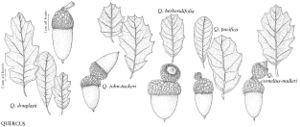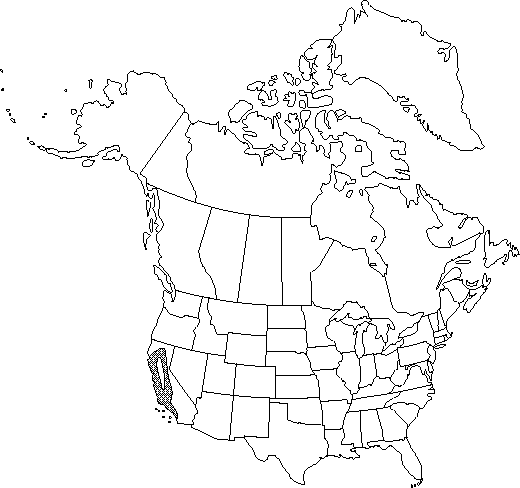Quercus berberidifolia
Overs. Kongel. Danske Vidensk. Selsk. Forh. Medlemmers Arbeider 1854: 172. 1854.
Shrubs, subevergreen, 1-2(-4) m. Bark gray, scaly. Twigs gray, yellowish, rarely reddish, 1-3 mm diam. Buds reddish brown, globose or ovoid, 2-3 mm, minutely puberulent. Leaves: petiole 2-4 mm. Leaf blade bicolored, obovate, elliptic, occasionally subrotund, planar or moderately convex, (10-)15-30 × (8-)10-20 mm, base truncate or rounded-attenuate, rarely cuneate, margins irregularly toothed and spinose, often sublobate, rarely entire, secondary veins (3-)4-7 on each side, apex broadly rounded or acute; surfaces abaxially waxy, light green or glaucous, with scattered minute, appressed, (4-)8(-10)-rayed hairs less than 0.2 mm diam. and sparse to dense yellowish, glandular hairs, adaxially glossy or dull green, glabrous or glabrate. Acorns solitary or paired, subsessile; cup hemispheric or turbinate, rarely shallowly cup-shaped, rim thick, 8-15 mm deep × 15-20(-22) mm wide, enclosing to 1/2 nut, scales reddish or yellowish, usually strongly, irregularly tuberculate, puberulent or canescent; nut light to dark brown, ovoid, ellipsoid, or barrel-shaped, (10-)15-30 × (8-)10-20 mm, apex rounded, glabrous at maturity. Cotyledons distinct.
Phenology: Flowering spring.
Habitat: Chaparral, margins of coastal sage scrub
Elevation: 100-1800 m
Discussion
The name Quercus dumosa (see species treatment no. 72) has often been applied to this species.
Quercus berberidifolia is the most common scrub oak of central and southern California, mostly at midelevations in the Coast Ranges. In central California it is replaced in drier interior habitats by Q. john-tuckeri, and south of the transverse ranges by Q. cornelius-mulleri. From Santa Barbara south, it does not descend to the low elevation coastal sites typical of Q. dumosa in the strict sense. Quercus berberidifolia hybridizes with numerous other white oaks of California. In southern California, putative hybrids with Q. john-tuckeri are noticeable in the mountains above Ventura and on the north slope of the Tehachapi Mountains.
Selected References
None.

